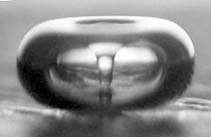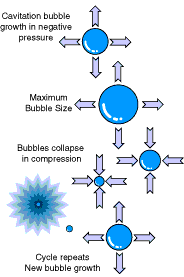Imagine you are riding a roller coaster. When you get to the top and the car free-falls speeding up until it reaches the bottom of the drop. And at the bottom, you would be crushed into your seat with a force equal to 1,000 billion times your weight. Obviously, more than your stomach would react to such a ride. As for the bubble, of air trapped in water, it responds to the extraordinary force by creating a flash of light only a tiny fraction of a second long. The light is mostly ultraviolet. Ultrasound wave can make the bubble repeat this wild free fall more than 30,000 times a second
Chemical effects of ultrasound enhance reaction rates because of the formation of highly reactive radical species formed during cavitation in forms of bubbles.


